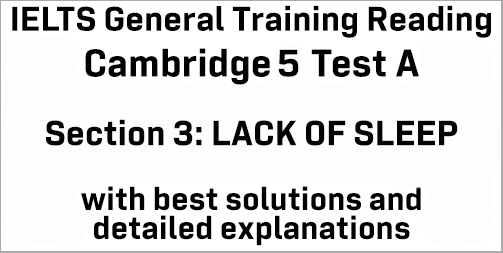IELTS General Training Reading: Cambridge 5 Test A Section 3; LACK OF SLEEP; with top solutions and best explanations
This General Training IELTS Reading post focuses on solutions to IELTS Cambridge 5 Reading Test A Section 3 that has a passage entitled ‘LACK OF SLEEP’. This is a targeted post for GT IELTS candidates who have big problems finding out and understanding Reading Answers in the GT module. This post can guide you the best to understand every Reading answer without much trouble. Finding out IELTS Reading answers is a steady process, and this post will assist you in this respect.
IELTS Cambridge 5 Test A: GT Reading Module
Section 3:
The title of the passage: LACK OF SLEEP
Questions 28-35: Identifying information
[This question asks you to find information from the passage and write the number of the paragraph (A, B, C or D … .. ) in the answer sheet. Now, if the question is given in the very first part of the question set, I’d request you not to answer them. It’s mainly because this question will not follow any sequence, and so it will surely kill your time. Rather, you should answer all the other questions first. And just like List of Headings, only read the first two lines or last two lines of the expected paragraph initially. If you find the answers, you need not read the middle part. If you don’t find answers yet, you can skim the middle part of the paragraph. Keywords will be a useful matter here.]
Question 28: the different amounts of sleep that people require
Keywords for this question: different amounts of sleep, people require,
Both the first and the last lines of section A talks about the same issue. Let’s have a look. In the first lines, the writer of this text says, “It is estimated that the average man or woman needs between seven-and-a-half and eight hours’ sleep a night. Some can manage on a lot less. … …”
Then, in the last lines of the section, the writer says again, “ . .. .. states that healthy individuals sleeping less than five hours or even as little as two hours in every 24 hours are rare, but represent a sizeable minority.”
These lines suggest the fact that different people require different amounts of sleep.
So, the answer is: A
Question 29: an investigation into the results of sleep deprivation
Keywords for this question: investigation, results of sleep deprivation,
In section C, look closely at the first few lines, “Researchers in San Diego deprived a group of men of sleep between Sam and lam on just one night, and found that levels of their bodies’ natural defences against viral infections had fallen significantly when measured the following morning. . .. …”
Here, Researchers = investigators, found that = results,
Therefore, in section C, these lines indicate that there was an investigation in San Diego on the results of sleep deprivation.
So, the answer is: C
Question 30: some reasons why people may suffer from sleep disorders
Keywords for this question: reasons why, people may suffer, sleep disorders,
The last half of section E talks about some causes of sleep disturbance or disorder. Let’s take a look at lines 10-16, “. . .. … Age aside, it is estimated that roughly one in three people suffer some kind of sleep disturbance. Causes can be anything from pregnancy and stress to alcohol and heart disease. Smoking is a known handicap to sleep, with one survey showing that ex-smokers got to sleep in 18 minutes rather than their earlier average of 52 minutes.”
From the explanation in these lines, we find out reasons for sleep disorders like pregnancy, stress to alcohol, heart disease and smoking.
So, the answer is: E
Question 31: lifestyle changes which can help overcome sleep-related problems
Keywords for this question: lifestyle changes, help overcome, sleep-related problems,
Section F, which is a small section, talks about some changes in lifestyle that can help us overcome sleep-related problems. Have a look at the section closely, “Apart from self-help therapy such as regular exercise, there are psychological treatments, including relaxation training and therapy aimed at getting rid of pre-sleep worries and anxieties. There is also sleep reduction therapy, where the aim is to improve sleep quality by strictly regulating the time people go to bed, and when they get up. Medication is regarded by many as a last resort and often takes the form of sleeping pills, normally benzodiazepines, which are minor tranquillizers.”
Here, we find about different therapies that change our lifestyle like regular exercise, relaxation training, sleep reduction therapy etc.
Here, strictly regulating the time people go to bed and when they get up = lifestyle change,
So, the answer is: F
Question 32: a process by which sleep helps us to remain mentally and physically healthy
Keywords for this question: process, sleep helps, remain, mentally and physically healthy,
Take a look at lines 1-8, where the writer talks about the process of ‘rest-and-repair theory’. “The latest beliefs are that the main purposes of sleep are to enable the body to rest and replenish, allowing time for repairs to take place and for tissue to be regenerated. One supporting piece of evidence for this rest-and-repair theory is that production of the growth hormone somatotropin, which helps tissue to regenerate, peaks while we are asleep. .. … ..”
So, the answer is: B
Question 33: claims about a commercialised man-made product for sleeplessness
Keywords for this question: commercialized man-made product, sleeplessness,
Read the last half of section G in order to find the answer to this question. Here, the writer explains, “ . .. . Melatonin pills contain a synthetic version of the hormone and are commonly used for jet lag as well as for sleep disturbance. John Nicholls, sales manager of one of America’s largest health food shops, claims that sales of the pill have increased dramatically. He explains that it is sold in capsules, tablets, lozenges and mixed with herbs. It is not effective for all insomniacs, but many users have weaned themselves off sleeping tablets as a result of its application.”
Here, it is sold = commercialised,
The claim is made by John Nicholls, the sales manager of one of America’s largest health food shops.
So, the answer is: G
Question 34: the role of physical changes in sleeping habits
Keywords for this question: role, physical changes, sleeping habits,
The very first lines of section E give us the answer to this question. “Sleeping patterns change with age, which is why many people over 60 develop insomnia. . .. .”
Here, Sleeping patterns = sleeping habits, change with age = physical changes,
So, the answer is: E
Question 35: the processes involved during sleep
Keywords for this answer: processes, during sleep,
In section D, lines 4-8 talks about the processes or stages that are involved during sleep. “. .. . Despite popular belief that sleep is one long event, research shows that, in an average night, there are five stages of sleep and four cycles, during which the sequence of stages is repeated. .. ..”
Then, the writer explains the stages in the following lines.
So, the answer is: D
Questions 36-40: TRUE, FALSE, NOT GIVEN
[In this type of question, candidates are asked to find out whether:
The statement in the question agrees with the information in the passage – TRUE
The statement in the question contradicts with the information in the passage – FALSE
If there is no information on this – NOT GIVEN
For this type of question, you can divide each statement into three independent pieces and make your way through with the answer.]
Question 36: Sleep can cure some illnesses.
Keywords for this question: Sleep, cure, some illnesses,
This passage talks about the role of sleep in our physical and mental refreshments and so on. However, we find no information on whether sleep cure any illnesses anywhere in the passage.
So, the answer is: NOT GIVEN
Question 37: The various stages of sleep occur more than once a night.
Keywords for this question: various stages, sleep, occur more than, once a night,
Take a look at section D where the various stages of sleep are explained. Here, the writer says in lines 5-8, “ .. . . in an average night, there are five stages of sleep and four cycles, during which the sequence of stages is repeated. . .. .. .”
Here, in an average night = once a night, the sequence of stages is repeated = various stages of sleep occur more than once,
So, the answer is: TRUE
Question 38: Dreaming and sleep-walking occur at similar stages of sleep.
Keywords for this question: Dreaming and sleep-walking, occur, similar stages of sleep,
The last half of section D gives us the answer to this question. The writer talks about stage four (sleep-walking stage) and stage five in sleeping (dream stage). Let’s read lines 11-24, “ . … . .. In stage four, usually reached after an hour, the slumber is so deep that, if awoken, the sleeper would be confused and disorientated. It is in this phase that sleep-walking can occur, with an average episode lasting no more than 15 minutes. In the fifth stage, the rapid eye movement (REM) stage, the heartbeat quickly gets back to normal levels, brain activity accelerates to daytime heights and above and the eyes move constantly beneath closed lids as if the sleeper is looking at something. During this stage, the body is almost paralysed. This REM phase is also the time when we dream.”
These lines indicate that dreaming and sleep-walking occur at different stages, not at similar stages.
So, the answer is: FALSE
Question 39: Sleepers move around a lot during the REM stage of sleep.
Keywords for this question: sleepers, move around a lot, during, REM stage, sleep,
The last few lines of section D gives the answer to this particular question. “ .. . .. In the fifth stage, the rapid eye movement (REM) stage, the heartbeat quickly gets back to normal levels, brain activity accelerates to daytime heights and above and the eyes move constantly beneath closed lids as if the sleeper is looking at something. During this stage, the body is almost paralysed. This REM phase is also the time when we dream.”
Here, almost paralysed = cannot move around at all,
So, the answer is: FALSE
Question 40: The body temperature rises relatively early in elderly people.
Keywords for this question: body temperature, rises, relatively early, elderly stage,
In section E, look at lines 6-8, “ . .. . The temperature rise occurs at daybreak in the young, but at three or four in the morning in the elderly. .. .. .”
Here, daybreak = day time, at three or four in the morning = at around dawn time,
This means the body temperature in elderly people rises early or quickly than in young people.
So, the answer is: TRUE
Click here for solutions to Cambridge 5 GT Test A Section 1
Click here for solutions to Cambridge 5 GT Test A Section 2




One thought on “IELTS General Training Reading: Cambridge 5 Test A Section 3; LACK OF SLEEP; with top solutions and best explanations”